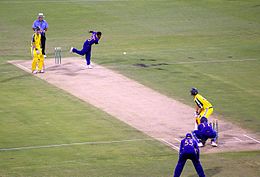
Back বোলিং (ক্রিকেট) Bengali/Bangla गेंदबाजी (क्रिकेट) Hindi ボウリング (クリケット) Japanese 볼링 (크리켓) Korean ബൗളിങ്ങ് Malayalam गोलंदाजी Marathi ਗੇਂਦਬਾਜ਼ੀ (ਕ੍ਰਿਕਟ) Punjabi گیند بازی PNB பந்து வீச்சாளர் Tamil బౌలింగ్ (క్రికెట్) Tegulu
This article needs additional citations for verification. (January 2013) |

Bowling, in cricket, is the action of propelling the ball toward the wicket defended by a batter. A player skilled at bowling is called a bowler;[1] a bowler who is also a competent batter is known as an all-rounder. Bowling the ball is distinguished from throwing the ball by a strictly specified biomechanical definition, which restricts the angle of extension of the elbow.[2] A single act of bowling the ball towards the batsman is called a ball or a delivery. Bowlers bowl deliveries in sets of six, called an over. Once a bowler has bowled an over, a teammate will bowl an over from the other end of the pitch.[3] The Laws of Cricket govern how a ball must be bowled.[4] If a ball is bowled illegally, an umpire will rule it a no-ball.[5] If a ball is bowled too wide of the striker for the batsman to be able to play at it with a proper cricket shot, the bowler's end umpire will rule it a wide.[6]
There are different types of bowlers, from fast bowlers, whose primary weapon is pace, through swing and seam bowlers who try to make the ball deviate in its course through the air or when it bounces,[7] to slow bowlers, who will attempt to deceive the batter with a variety of flight and spin. A spin bowler usually delivers the ball quite slowly and puts spin on the ball, causing it to turn at an angle while bouncing off the pitch.[8]
A team can be said to have elected to "have a bowl" when it wins the coin toss and chooses to field.[9]
- ^ "Terms | Cricket Web". www.cricketweb.net. Retrieved 31 August 2020.
- ^ "International Cricket Council". www.icc-cricket.com. Retrieved 31 August 2020.
- ^ "Glossary of cricket terms & sayings". www.wandererscricket.com. Retrieved 31 August 2020.
- ^ "Laws of Cricket: Law 42 (Fair and unfair play)". Lords.org. Archived from the original on 5 January 2013. Retrieved 23 January 2013.
- ^ "Laws of Cricket: Law 24 (No ball)". Lords.org. Archived from the original on 27 December 2012. Retrieved 23 January 2013.
- ^ "Laws of Cricket: Law 25 (Wide ball)". Lords.org. Archived from the original on 24 November 2012. Retrieved 23 January 2013.
- ^ "The Different Types Of Fast Bowlers In Cricket Explained!". Cricketers Hub. Retrieved 31 August 2020.
- ^ "SPIN BOWLER | definition in the Cambridge English Dictionary". dictionary.cambridge.org. Retrieved 31 August 2020.
- ^ Omnisport (16 November 2017). "Memorable Ashes Moments: 'We're gonna have a bowl' - Hussain's coin toss horror-show". www.sportskeeda.com. Retrieved 2 December 2020.